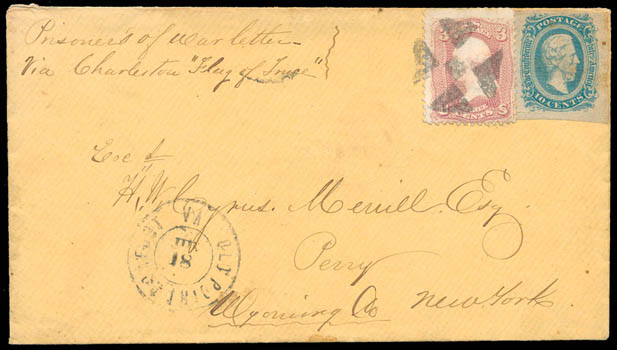
Lot
4384 
Confederacy, Andersonville Ga. (Camp Sumter), 1864 cover from a prisoner-of-war to Perry, N.Y., manuscript "Exd. H.W" by Camp Commandant Capt. Henry Wirz, endorsed "Prisoners of War Letter / Via Charleston Flag of Truce", mixed franking with C.S.A. postage to Richmond paid by uncancelled 10¢ blue (11), light horiz. crease, and U.S. postage paid with 3¢ rose (65), tied by quartered cork, "Old Point Comfort Va. Jun 18" cds, Very Fine. Estimate $3,000 - 4,000.
A WONDERFUL MIXED-FRANKING PRISONER-OF-WAR COVER FROM ANDERSONVILLE, CENSORED BY INFAMOUS CAMP COMMANDANT HENRY WIRZ.
Henry H. Wirz took command of Andersonville (Camp Sumter) beginning in March 1864. After the war, Wirz was charged with conspiracy and murder by Federal authorities. His trial was held in the Capitol building in Washington and was presided over by Union General Lew Wallace. A number of former prisoners testified on conditions at Andersonville, many accusing Wirz of specific acts of cruelty (some of these accounts were later called into question by historians as exaggerated or false). The court also heard from Confederate officers and considered official correspondence from captured Confederate records. Wirz presented evidence that he pleaded to Confederate authorities to try to get more food and maintained that he tried to improve the conditions for the prisoners. Wirz was found guilty of murder and was sentenced to death. On November 10, 1865, he was hanged in Washington at the site of the current Supreme Court building -- the only Confederate official to be tried, convicted and executed for war crimes resulting from the Civil War.
The prisoner, Union soldier Merrill, was captured at Plymouth N.C. and later died at the Andersonville Camp later in Summer 1864.
Realized: $4,750


Lot
4385 
Confederacy, Charleston "Union 600" (Roper Hospital), blue cover endorsed "From Prisoner of War, Charleston S.C." and original enclosed letter datelined "Military Prison Charleston S.C., Oct 4th 1864", manuscript "Exd" and additional red manuscript "Soldiers Letter, W. I. Bennett, Lt col & Agt - Ex, DS" examiner's marking, entered mails with "Port Royal S.C. Nov 13 1864" cds and matching "Due 3" rating; small edge tear and some tone spots, Very Fine. Estimate $1,500 - 2,000.
A SCARCE PRISONER-OF-WAR COVER FROM A UNION OFFICER ON THE CONFEDERATE SIDE OF THE INFAMOUS "600" STALEMATE.
Original letter mentions, "I have not written to you for several months. partly because the mails have been so irregular that I feared letters would not reach you, and partly waiting in hopes to hear from you. We have received no regular mail now for four months, but now communication is reestablished. Since leaving Richmond I have been at Macon and Savannah Ga. and but recently arrived here…"
There are many interesting stories of prisons and one of the most interesting is that of three Southern locations where captured Confederate officers were held by Federal forces, right in the bosom of the Confederacy itself. These three prisons were Morris Island in Charleston Harbor, SC, Hilton Head in the harbor of Port Royal, SC, and Fort Pulaski near Savannah, GA. All are interconnected with the plight of 600 Confederate officer prisoners known in Southern history as "The Immortal 600."
The story begins in June 1864 when the Confederates placed 50 high-ranking Union officer prisoners in Charleston where the Union believed they would be subject to Union artillery fire from Morris Island. The North promptly sent a similar number of Confederate officers to Morris Island to be exposed to Confederate artillery. On August 3, 1864, both sides exchanged these prisoners. Then the Confederates transferred 600 more prisoners to Charleston. On August 20, 1864, the Union retaliated by shipping 600 prisoners from Fort Delaware to Morris Island near Charleston, arriving on September 7. They were held in open barracks as "human shields" under direct shelling from Confederate forces in retaliation for Union prisoners being held in Charleston under shelling from U.S. forces. General Grant vetoed another prisoner exchange, however, the stalemate was broken when the Union prisoners were moved from Charleston because of an outbreak of yellow fever.
Realized: $3,500

Lot
4386 
Confederacy, "Immortal Confederate 600" - Morris Island Prison (Charleston, S.C.), orange prisoner cover endorsed "W. E. Johnson, Prisoner of War" to his wife at Liberty Hill S.C., additional "Flag of Truce" and "Care of Col. John F Iay" endorsements, red manuscript "EX" Union examiner's marking, entered C.S.A. mails with "Charleston S.C. Jan 8" cds and matching large "10" due rating handstamp (CSA type K), Very Fine, ex-Kohn. Estimate $1,500 - 2,000.
A CHOICE USE FROM ONE OF THE IMMORTAL 600 CONFEDERATE PRISONERS MOVED TO MORRIS ISLAND BY FEDERAL FORCES.
The "Immortal 600" was a group of 600 prisoners, all Confederate officers, moved from Fort Delaware to be sent to Morris Island in Charleston harbor in August 1864 and held in open barracks exposed to mortar fire from Confederate batteries.
This extraordinarily inhumane act was the Federal response to an equally repulsive act on the part of Confederates in Charleston, who exposed Union prisoners to bombardment from Federal forces within range of the city. This sorry chapter of the war ended in a stalemate in October 1864. Covers from Confederate prisoners imprisoned on Morris Island are very rare.
Realized: $1,800
